Acer Aspire One 751h: NetbookSize++
by Jarred Walton on September 3, 2009 12:00 AM EST- Posted in
- Laptops
Netbook Battery Life Comparison
We run many scenarios for our battery life tests. Since most netbooks don't include optical drives, we ripped our standard test DVD to a hard drive and copied those files over. Obviously there's a benefit to not powering a spinning DVD, but even without that advantage the netbooks provide much better battery life than higher performance laptops. We also have DivX HD, and Xvid tests to show if there's a difference in codec performance -- as noted, smooth/acceptable x264 playback was not (currently) possible on the 751h.
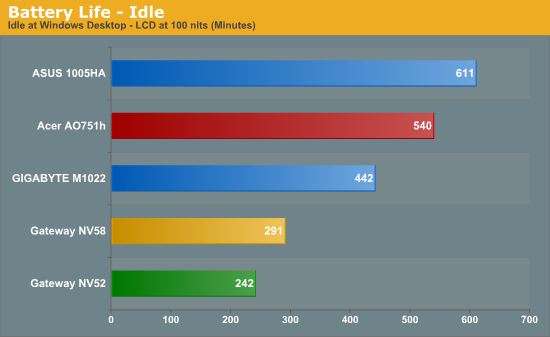
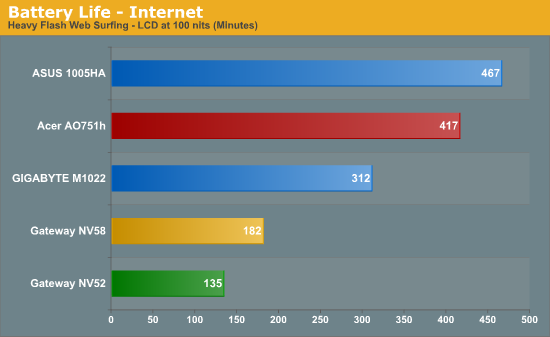
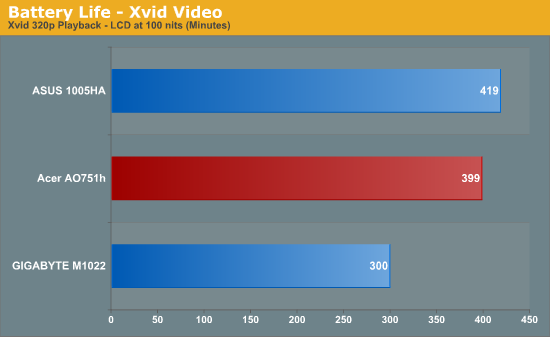

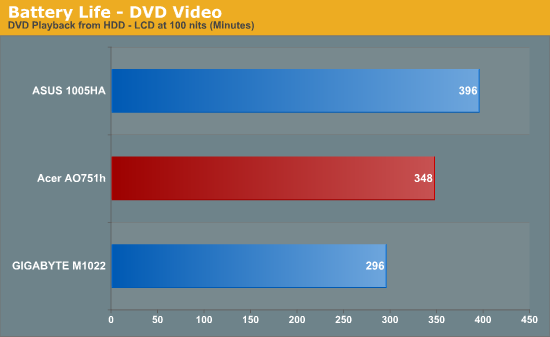
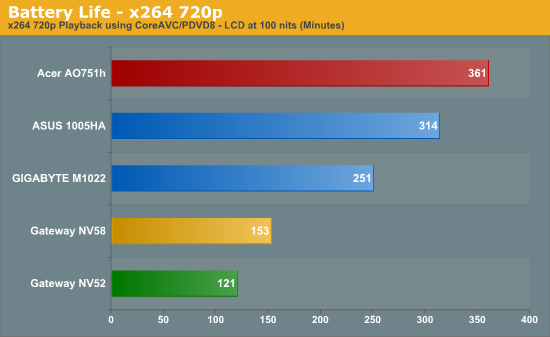
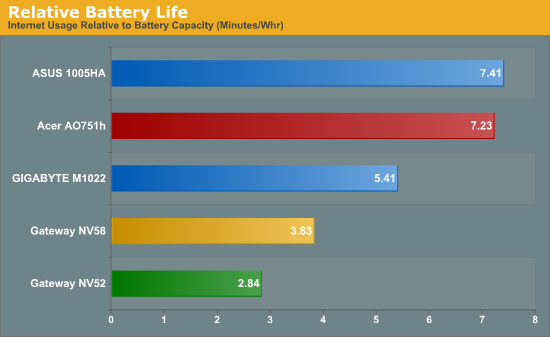
Here's where the compromise in choice of processor/chipset pays off. Acer is able to include a larger LCD panel but still provide very good battery life, nearly equaling the ASUS 1005HA in several tests. It's particularly interesting to note that DivX and Xvid battery life is much closer than DVD battery life -- odd considering the GMA 500 is supposed to have better MPEG-2 support than the GMA 950. Whatever the cause, the ASUS 1005HA offers 12 to 14% more battery life in most instances, but only 5% more battery life in Xvid playback and virtually identical playback during DivX decoding (a difference of less than 2%, which is about the margin of error for our battery life tests). The battery life relative to battery capacity puts things in perspective, and the 751h ends up trailing the ASUS 1005HA by just 2.5%.
Where things get really interesting is in the x264 playback test. Note how the Acer 751h suddenly vaults into first place, and not by a small margin. Thanks to the H.264 acceleration in the GMA 500 (using the PowerDVD 8 H.264/AVC Decoder), the 751h is able to offer 15% more battery life than the ASUS 1005HA. It can even handle 1080p x264 should you have appropriate videos, which is not something you can do on the N280+GMA 950 combination. CPU usage is quite a bit lower on the 751h than the 1005HA/M1022 during x264 playback, typically hovering around 30-40% (compared to 70-80%). With the higher resolution display, the benefits of a higher quality codec like x264 are clearly present, and you don't even need to sacrifice a lot of battery life. It's a shame performance in other areas (i.e. general 2D/3D performance) isn't nearly this impressive.
Netbook Power Requirements
As a corollary to the battery life tests, we also performed measurements of power requirements using the AC adapters and a Kill-A-Watt device. These numbers are only accurate to the nearest Watt, so a difference of 1W (i.e. from rounding) could obscure up to a 12% actual difference in power requirements. Also note that power requirements change when you switch to DC power, so the battery life tests are a better indication of a true power requirements. Still, it's interesting to see just how little power these netbooks consume relative to entry-level laptops -- let alone your typical gaming desktop.
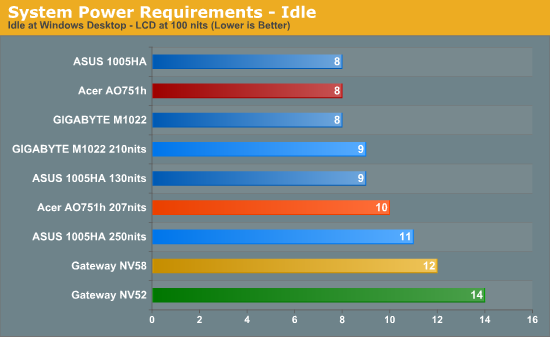
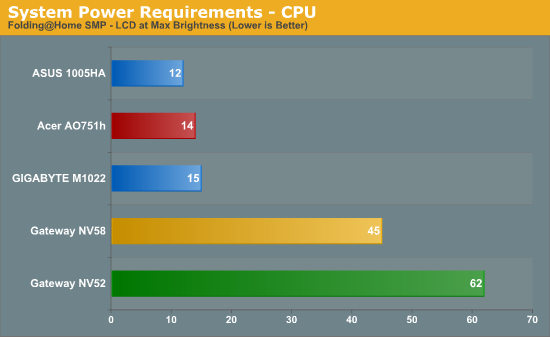
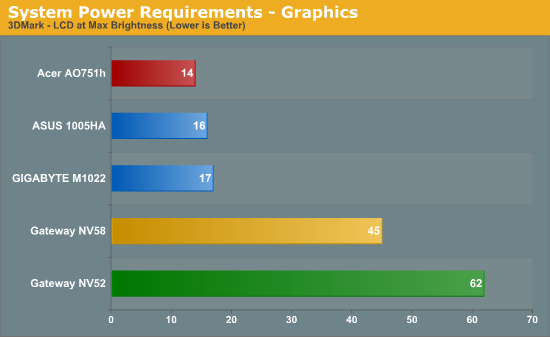
As you would expect, power requirements more or less mirror what we see in the battery life results. Without using EeeCTL to increase the brightness level on the 1005HA, it typically has the lowest power draw of the tested netbooks. Running a 3D application changes the situation slightly, but that's mostly because the GMA 500 doesn't perform nearly as fast as the (already slow) GMA 950.










30 Comments
View All Comments
Finally - Thursday, September 3, 2009 - link
...but what's the keyboard size?A bigger, higher resolution display is definitely the way to go, but I want full-sized keys and a non-glossy display - and that's the reason why I haven't bought any netbooks yet.
JarredWalton - Thursday, September 3, 2009 - link
If you look at the gallery, you can see the keyboard makes use of the whole area - i.e. no unused space on the right and left sides. I believe the keys are 100% standard desktop keyboard sized, though obviously it's not a 101-key layout. I felt the keyboard was definitely better than the smaller 10.1" and 9.1" netbooks.TA152H - Thursday, September 3, 2009 - link
It's strange to read an article without P55 motherboard pictures. Is this site under new management?I'm in the market for one of these, but I'd never tolerate the slower clock speed processor. When you factor in the very insignificant power difference, I don't think the processor is attractive for most people. Whatever percentage less it is than the N270/N280, they are very low percentages of the power draw for the computer, so it's really not going to make a big difference in systemic power draw.
Really, Intel kind of did something very un-Intel with the Atom. Even when they had the dreadful Netburst processors, they at least surrounded them with good packaging, including software compilers, good chipsets, good motherboards, etc...
With the Atom, from a purely processor perspective, they have a really nice product, but they shackle it with a perfectly dreadful chipset. It's bizarre. On top of that, they're taking too long to get out something better. I'm really getting impatient waiting to be able to buy one of these things, since I won't buy 945, and I won't buy NVIDIA crap. I wish AMD had something decent, but they don't, so a lot of us just have to wait.
Also, these mirror like screens are a nightmare, and becoming more popular. Especially for something ultra-portable, don't these makers realize that people bring them outside? They must be cheaper to make, since they seem to go to great efforts to convince us that we want them, but I don't. Is anyone else a little annoyed by the number of mirrors they sell parading as displays? It's not so bad if there's a choice, but more and more, it's getting difficult to get an anti-glare screen.
chrnochime - Thursday, September 3, 2009 - link
You might want to consider the Samsung NC20, which comes with via nano cpu + chrome graphics. Not that blazing fast, but if tunes correctly ,goes at least as fast as the N270/280, and does basic work fine. Another is the Lenovo S20, which costs about the same, ~400USD.If you need a decent fast CPU, consider the Acer Timeline. The base 3810T(13.3") comes with a ULV Intel processor that's more akin to Pentium M than the atom. Priced around 500 I think. That or higher priced, with Core 2 Solo, or even Core 2 duo.
I might've gotten the CPU model name wrong in the timeline, but the CPUs in the timelines are much better than the Atom...
Penti - Wednesday, September 9, 2009 - link
Actually just get Intel CULV if you need more performance, they will also have chipsets available that does have working hw acceleration of video. (The 11.6" Timeline/aspire is CULV, 1.3GHz Penryn based).The prices for the CULVs are decent any way, considering you also get a real version of windows with it. HW acceleration at least works on GS40/GMA4500MHD. Which means a lot on small less powerful notebooks. And you get W7 upgrade too. Costs only around $450. Still is about the size of a large netbook. I think it got a C2S 1.4GHz for that price though. No real reason to go to atoms for such devices any how.
TA152H - Thursday, September 3, 2009 - link
To be honest, as much as I wanted to like the Nano, to me it's a big disappointment as it currently exists. I don't really this this as a competitive processor in most situations. Where you can get the power down to the point it matches the Atom, it gets beaten in a lot of benchmarks, and if you use one of the higher power ones, you start running into Core 2 territory, or one of the lesser derivatives of it. Given the really excellent Intel designs, Centaur had to get theirs right, and so far it's just not there. Possibly a shrink to 45nm will improve the power characteristics, and some tweaking might improve performance, so I'm still hopeful. But, as it exists today, it's interesting, but not particularly useful. The bad part is, at least for them, is it will get a lot more difficult once Intel comes out with a decent chipset and moves to 32nm. Their own chipsets are still stuck at DX 9, and aren't particularly good either.They had a long time being alone in that market, and they've had a pretty long time where Intel had the processor, but not the chipset. They failed miserably even with that. They came out with nice form factors and such, but never really broke into the market because their products basically suck. I have an 800 MHz part that gets raped by my K6-III+, underclocked to 400 MHz. It uses less power, generates less heat, and outperforms the VIA chip, despite being roughly 6 years older. Now the Nano was a big step up, and maybe it's good if you take it outside of the context of excellent Intel processors, but, within the context of what exists in the marketplace, I don't see it making much sense for a lot of buyers. Again, I'm not blaming them entirely; AMD can't compete with Intel either. It's probably just that Intel makes such attractive products, positioning against them is extremely difficult. On the other hand, still being on 65nm, and not supporting DX10 are issues not related to Intel, that should have been taken care of a while ago. They can't make mistakes like this.
I was looking at Core 2 based notebooks, but it's gotten to the point where I couldn't find a anti-glare screen at HP. I'm allergic to Dell, and merely disgusted with HP. I won't buy Lenovo, since they're Chinese and not American, and we already import too much from them. Sadly, I don't know much about makers, since I don't buy from them, and don't have a job where I have to deal with them. It's a pity there's no way to build a notebook, but, sadly, we have to buy from companies we know suck. It's a disagreeable situation, but, what can one do if they need one of these things?
Etern205 - Thursday, September 3, 2009 - link
Out of all of them, there is only one model which has Windows XP Professional instead of XP Home.Etern205 - Thursday, September 3, 2009 - link
Never mind looks like it's already mentioned.bjacobson - Thursday, September 3, 2009 - link
I wouldn't worry about it. Better to get the Vista version and get the free upgrade to Windows 7.I have an AO751h and absolutely love it. Installed 2g of ram myself, Windows 7, turn off window transparency and you're good to go-- this thing has 6-8h battery life depending on how bright the screen is (I seem to get 7h with it on the lowest brightness setting) and is FAST. The GMA500 graphics chip can accelerate 1080p video-- if you get the drivers installed right (don't run the setup.exe from Intel, make sure you install through Device Manager).
Whatever tweaking they did to Windows 7 to make it faster than Vista WORKED. Idles at ~1-3% with that Atom, and is very responsive once you get Chrome running (Firefox a bit slower). Now I give them about a year before they add the bloat back in through "Security" updates and it slows to a grinding halt (just like what happened to XP).
The0ne - Thursday, September 3, 2009 - link
As I've been telling unbelievers of Windows 7, all they really to do is install it on a older desktop/laptop and see the difference. Whatever MS changed with Windows 7 it's working wonders on older PCs and even newer crawling PCs with Vista pre-installed.I'm waiting for someone to find out why this is so as I'm too lazy and no time! to look into it myself :D